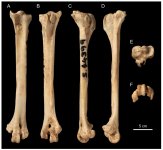Systematics
The morphology of the Rapa Iti tarsometatarsus indicates that it could only belong to the Order Gruiformes and family Rallidae, given the resence of two open tendinal canals, one distal foramen, and the tendinal bridge [19]. More specifically, the Rapa Iti fossil can be allocated to the genus Gallirallus due to the following diagnostic features of the tarsometatarsus (as per [8]: p. 8): “corpus tarsometatarsi much wider than deep; medial sulcus hypotarsi not enclosed; fossa parahypotarsalis medialis shallow in proximal aspect; fossa metatarsi I short and shallow; crista plantaris mediana slopes gradually (not
steeply) to hypotarsus; distal end of trochlea metatarsi tertii sloped toward medial trochlea; cotyla medialis is rectangular in proximal aspect with flat (not rounded) dorsal margin”. According to our comparative analysis with tarsometatarsi of living and extinct species
of Gallirallus (see below), we are confident in assigning the present fossil to a new species, apparently endemic to Rapa Iti.
Family Rallidae
Genus Gallirallus Lafresnaye, 1841
Gallirallus astolfoi sp. nov.
ZooBank reg. nr.: urn:lsid:zoobank.org:act:F606759B-4C48-491E-93F0-0E8C018B3B97.
Holotype: NMNZ S.044399 (left tarsometatarsus; A. Anderson col. 21/vii/2002).
Type locality: French Polynesia, Rapa Island (Rapa Iti), Tangarutu Cave, Section S1 (30–40 cm).
Etymology: The specific epithet honours Astolfo, one of Charlemagne’s fictional paladins. In the epic Orlando Furioso, Astolfo becomes trapped on a remote island because of the sorceress Alcina.
Diagnosis: Tarsometatarsus small (ca. 34.5 mm long), of delicate appearance, with narrow and shallow shaft, and narrow trochleae (particularly the trochlea metatarsi II).
Differential diagnosis: The tarsometatarsus of Gallirallus astolfoi sp. nov. (Figure 1) is considerably smaller than most other congeners (Table 1), with the exception of G. ripleyi from the Cook Islands and G. wakensis from the Wake Island, both flightless and extinct [8,24]. Its shaft, however, is proportionately much narrower and shallower, which
gives the bone a more delicate appearance. The Chatham Island rail G. modestus (previously classified into its own genus, Cabalus) is much smaller and its tarsometatarsi have a more compact appearance.
The single known tarsometatarsus of G. huiatua from Niue is similar to that of G. astolfoi sp. nov. in its delicate appearance (i.e., shaft width and depth, and trochleae width), but it is more elongate. The tarsometatarsus of G. pendiculentus from the Northern Marianas and of G. steadmani from Tubuai, French Polynesia, are similar in shape to G.
astolfoi sp. nov. but are much larger (Table 1). Furthermore, G. steadmani apparently has proportionately narrower trochlea (trochlea metatarsorum III and IV), though that could have been overemphasized by the sub-optimal preservation of the specimens ([27]: figure 4L).
In comparison with larger congeners, the tarsometatarsus of G. astolfoi sp. nov. is more delicate, with its proportionately narrower and shallower mid and distal shaft, as well as its narrower trochleae. Compared with G. philippensis and other species from French
Polynesia, namely G. epulare from Nuku Hiva, G. roletti from Tahuata, and G. storrsolsoni from Huahine, the latter two, in particular, have much stouter tarsometatarsi, with a wider mid-shaft ([24]: figure 6A,B). Furthermore, the trochlea of digit 2 (trochlea metatarsi II) of G. astolfoi sp. nov. is less expanded than in G. philippensis and some island-endemic congeners such as G. roletti and G. dieffenbachii.
There are two further extinct endemic flightless species from French Polynesia: G. gracilitibia from Ua Huka and G. pacificus from Tahiti [12,24] (Table 1). No tarsometatarsi are known for these taxa, which precludes comparison with G. astolfoi sp. nov. Nevertheless, there is little chance that they could be conspecific as these islands are respectively 2100 km and 1200 km away from Rapa Iti. The only other Rallidae species on Rapa Iti is the widespread and much smaller spotless crake, Zapornia tabuensis (Gmelin, 1789) [5]. There
is a further undescribed fossil species, Gallirallus sp. of [26], that is endemic to Rurutu (and extinct), though there is no published information or photographs available.
Fred
Figure 1. Left tarsometatarsus (holotype, NMNZ S.044399) of Gallirallus astolfoi sp. nov. in different views: (A) anterior, (B) caudal, (C) lateral, (D) medial, (E) proximal, (F) distal.







